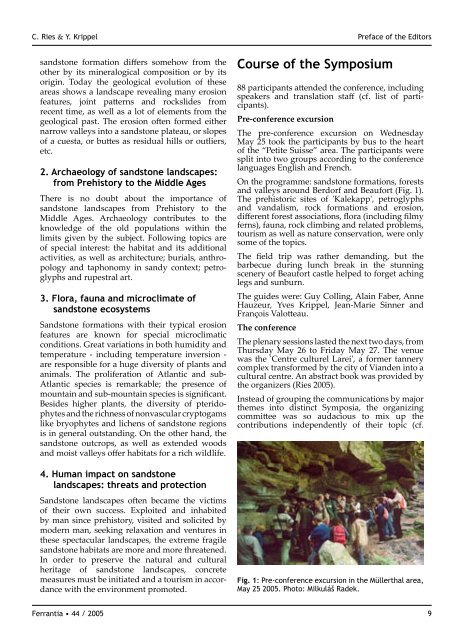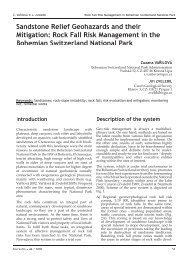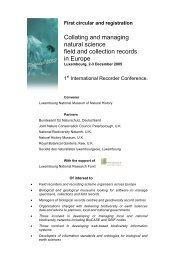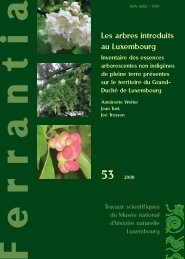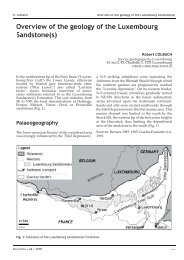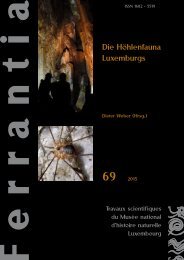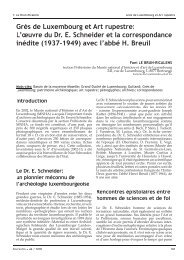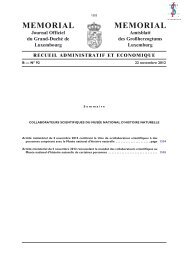Preface of the Editors - Musée national d'histoire naturelle
Preface of the Editors - Musée national d'histoire naturelle
Preface of the Editors - Musée national d'histoire naturelle
Create successful ePaper yourself
Turn your PDF publications into a flip-book with our unique Google optimized e-Paper software.
C. Ries & Y. Krippel <strong>Preface</strong> <strong>of</strong> <strong>the</strong> <strong>Editors</strong>sandstone formation differs somehow from <strong>the</strong>o<strong>the</strong>r by its mineralogical composition or by itsorigin. Today <strong>the</strong> geological evolution <strong>of</strong> <strong>the</strong>seareas shows a landscape revealing many erosionfeatures, joint paerns and rockslides fromrecent time, as well as a lot <strong>of</strong> elements from <strong>the</strong>geological past. The erosion oen formed ei<strong>the</strong>rnarrow valleys into a sandstone plateau, or slopes<strong>of</strong> a cuesta, or bues as residual hills or outliers,etc.2. Archaeology <strong>of</strong> sandstone landscapes:from Prehistory to <strong>the</strong> Middle AgesThere is no doubt about <strong>the</strong> importance <strong>of</strong>sandstone landscapes from Prehistory to <strong>the</strong>Middle Ages. Archaeology contributes to <strong>the</strong>knowledge <strong>of</strong> <strong>the</strong> old populations within <strong>the</strong>limits given by <strong>the</strong> subject. Following topics are<strong>of</strong> special interest: <strong>the</strong> habitat and its additionalactivities, as well as architecture; burials, anthropologyand taphonomy in sandy context; petroglyphsand rupestral art.3. Flora, fauna and microclimate <strong>of</strong>sandstone ecosystemsSandstone formations with <strong>the</strong>ir typical erosionfeatures are known for special microclimaticconditions. Great variations in both humidity andtemperature - including temperature inversion -are responsible for a huge diversity <strong>of</strong> plants andanimals. The proliferation <strong>of</strong> Atlantic and sub-Atlantic species is remarkable; <strong>the</strong> presence <strong>of</strong>mountain and sub-mountain species is significant.Besides higher plants, <strong>the</strong> diversity <strong>of</strong> pteridophytesand <strong>the</strong> richness <strong>of</strong> nonvascular cryptogamslike bryophytes and lichens <strong>of</strong> sandstone regionsis in general outstanding. On <strong>the</strong> o<strong>the</strong>r hand, <strong>the</strong>sandstone outcrops, as well as extended woodsand moist valleys <strong>of</strong>fer habitats for a rich wildlife.4. Human impact on sandstonelandscapes: threats and protectionSandstone landscapes oen became <strong>the</strong> victims<strong>of</strong> <strong>the</strong>ir own success. Exploited and inhabitedby man since prehistory, visited and solicited bymodern man, seeking relaxation and ventures in<strong>the</strong>se spectacular landscapes, <strong>the</strong> extreme fragilesandstone habitats are more and more threatened.In order to preserve <strong>the</strong> natural and culturalheritage <strong>of</strong> sandstone landscapes, concretemeasures must be initiated and a tourism in accordancewith <strong>the</strong> environment promoted.Course <strong>of</strong> <strong>the</strong> Symposium88 participants aended <strong>the</strong> conference, includingspeakers and translation staff (cf. list <strong>of</strong> participants).Pre-conference excursionThe pre-conference excursion on WednesdayMay 25 took <strong>the</strong> participants by bus to <strong>the</strong> heart<strong>of</strong> <strong>the</strong> “Petite Suisse” area. The participants weresplit into two groups according to <strong>the</strong> conferencelanguages English and French.On <strong>the</strong> programme: sandstone formations, forestsand valleys around Berdorf and Beaufort (Fig. 1).The prehistoric sites <strong>of</strong> 'Kalekapp', petroglyphsand vandalism, rock formations and erosion,different forest associations, flora (including filmyferns), fauna, rock climbing and related problems,tourism as well as nature conservation, were onlysome <strong>of</strong> <strong>the</strong> topics.The field trip was ra<strong>the</strong>r demanding, but <strong>the</strong>barbecue during lunch break in <strong>the</strong> stunningscenery <strong>of</strong> Beaufort castle helped to forget achinglegs and sunburn.The guides were: Guy Colling, Alain Faber, AnneHauzeur, Yves Krippel, Jean-Marie Sinner andFrançois Valoeau.The conferenceThe plenary sessions lasted <strong>the</strong> next two days, fromThursday May 26 to Friday May 27. The venuewas <strong>the</strong> 'Centre culturel Larei', a former tannerycomplex transformed by <strong>the</strong> city <strong>of</strong> Vianden into acultural centre. An abstract book was provided by<strong>the</strong> organizers (Ries 2005).Instead <strong>of</strong> grouping <strong>the</strong> communications by major<strong>the</strong>mes into distinct Symposia, <strong>the</strong> organizingcommiee was so audacious to mix up <strong>the</strong>contributions independently <strong>of</strong> <strong>the</strong>ir topic (cf.Fig. 1: Pre-conference excursion in <strong>the</strong> Müllerthal area,May 25 2005. Photo: Milkuláš Radek.Ferrantia • 44 / 2005 9


